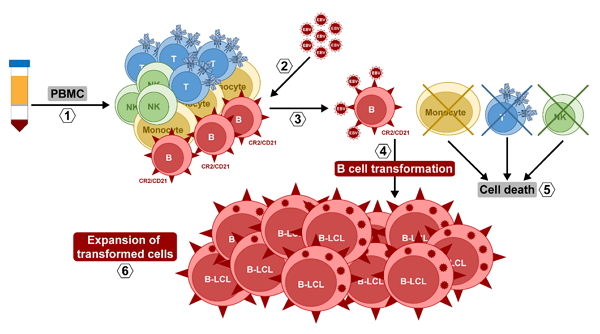B CELL IMMORTALIZATION
|
Description |
Epstein-Barr virus (EBV) belongs to the herpesvirus family and it is the main agent that cause human mononucleosis. 95% approximately of adults are carriers of this virus and have high positive titer persistence through time. Lymphoblastoid marmoset cell line B95-8 (Callithrix genus) was established by the infection of marmoset B cells with EBV isolated from a patient with infectious mononucleosis. B95-8 cell line provides a source of EBV to generate continuous B lymphoblastoid lines from human donors. By DNA profiling, it has been confirmed that B95-8 cell line was actually derived from a cotton-top tamarin (Saguinas oedipus) instead of marmoset. This virus selectively infect B lymphocytes from a mixture of T, B and NK cells from peripheral blood lymphocytes (PBL) through complement receptor 2 (also known as CD21).
|
How does it work |
For B cell immortalization with EBV (Fig. 1) cells are isolated (day 0) from healthy donor or patient peripheral blood with a density gradient using Ficoll (GE Healthcare). Isolated peripheral blood lymphocytes are resuspended in culture supernatant from B95-8 cell line (that contains the Epstein-Barr virus) in a 1:1 proportion with RPMI-1640 (Lonza) supplemented with 20% FBS, 1% glutamine, 1% antibiotic-antimycotic (Gibco), and 20 µg/mL PHA (Sigma-Aldrich). During the first two weeks after the infection, the culture is maintained once-twice per week with RPMI-1640, supplemented with 20% FBS, 1% glutamine and 1% antibiotic-antimycotic. Once lymphoblastoid clones are formed, cells need to be immunophenotyped to verify if they are CD19 positive, and after this confirmation, they can be subculture with complete medium with 10% FBS.

B cell immortalization with Epstein-Barr virus. (1) Isolation of peripheral blood mononuclear cells (PBMC) by density gradient. (2) Addition of B95-8 culture supernatant containing the EBV. (3) EBV infect B cells specifically through CR2/CD21 receptor. (4) Once inside, EBV transform B lymphocytes into B-lymphoblastoid cell lines (B-LCL), while the rest of PBMC that have not been infected die. (5). (6) When they are transformed/immortalized, B-LCL proliferate and expand.
|
Advantages |
This technique preserves functional genomes from B lineage and it is useful for:
- B cell specific pharmacological preclinical assays.
- Preserve intrinsic B cell defects.
- Repository of genomic DNA and specific RNA to lineage B.
|
Where has it been developed |
This technique has been developed in the Immunology Department, at the Faculty of Medicine of Complutense University of Madrid. The research group, apart from collaborate immortalizing B cells, has consolidated a research topic based in human T cell physiopathology, with significant publications in the generation and characterization of in vitro models of the development and pathology of T lymphocytes using HTLV-1, an immortalizing agent similar to that in Epstein-Barr virus with B cells.
Immortalized B cells can help to:
- Have genetic material for the detection of mutations from inmunodeficient patients when blood samples are scarce.
- Detect the cellular and molecular base of Common variable Immunodeficiency (CVID).
|
And also |
This research group offers the following additional services:
- Generation of T lymphocyte lines
- Viability problems solutions
- In vitro functional evaluation of the material generated. Pharmacological assays comparing other lineages (B cells, peithelial cells, …)
- Cryopreservation service
|
Contact |
|
© Office for the Transfer of Research Results – UCM |
|
PDF Downloads |
|
Classification |
|
Responsible Researcher |
José R. Regueiro González-Barros: regueiro@med.ucm.es
Department: Immunology, Ophthalmology and Otolaryngology
Faculty: Medicine


